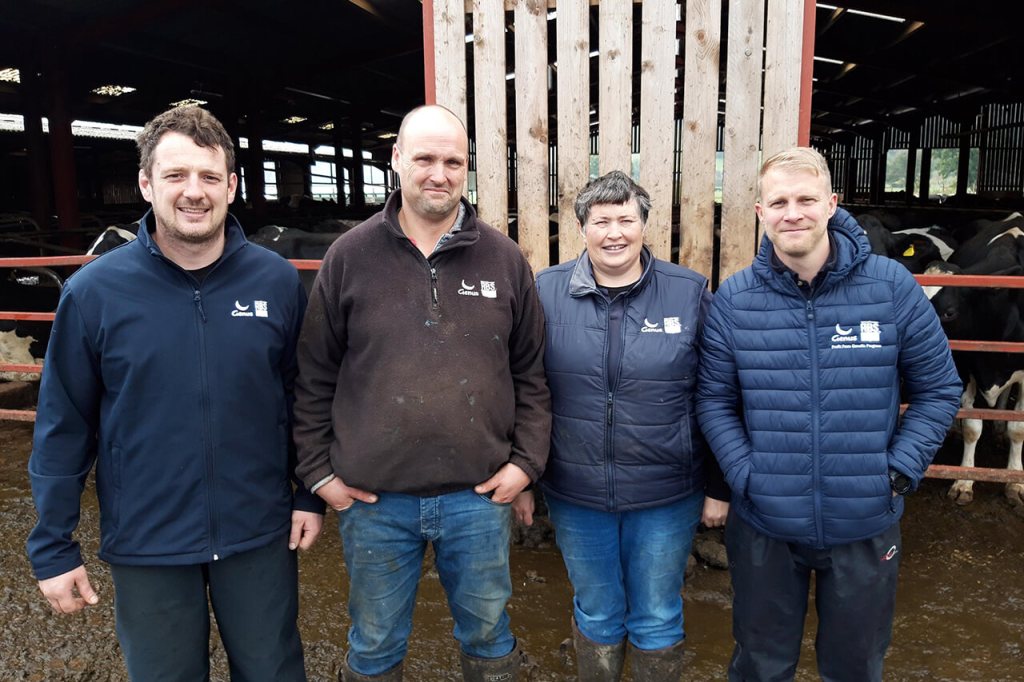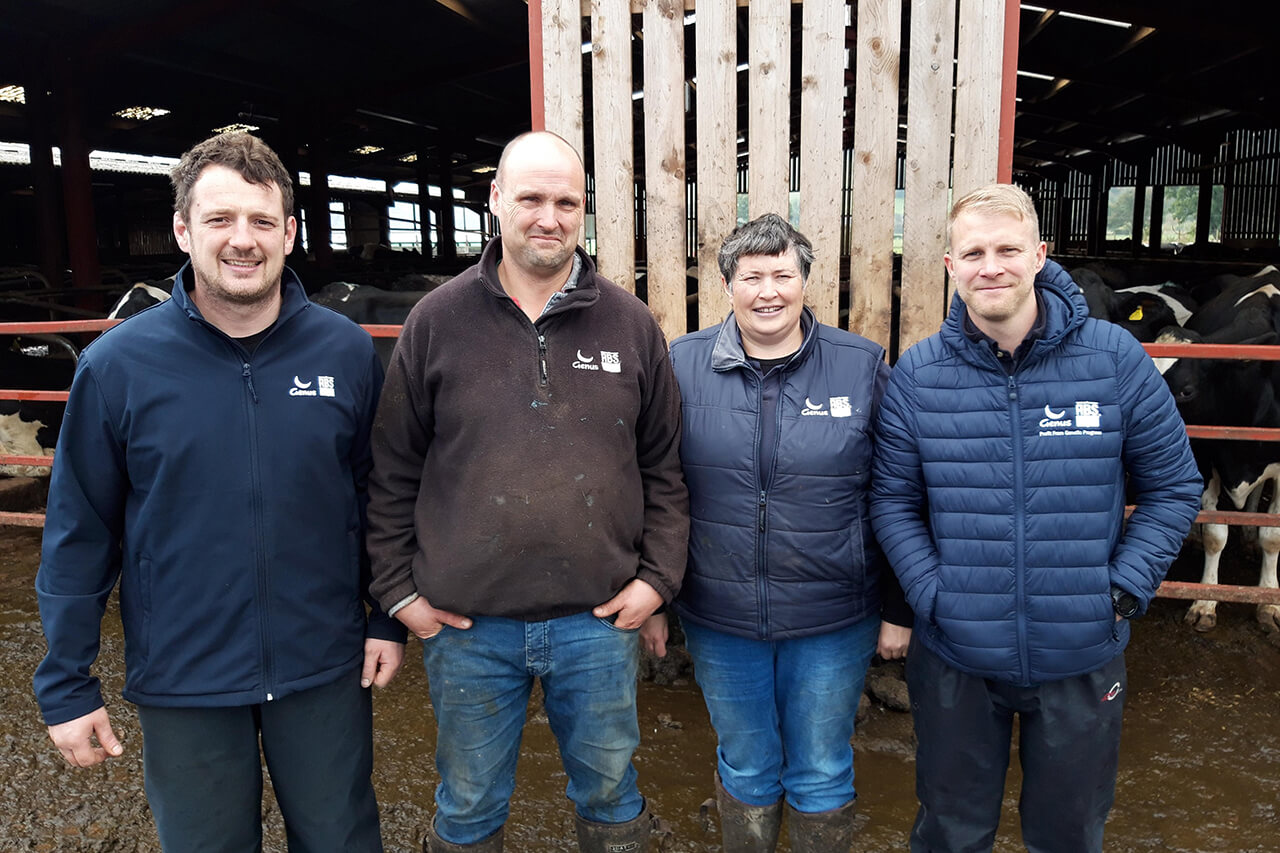Husband and wife team Stephen and Sarah Suckley-Jones farm the 162ha Banhadla Farm, Llangedwyn near Oswestry with Sarah’s father David. The farm is home to the 320 head Banhadla herd.
“We have found 320 is the right number of cows for the farm and buildings,” Sarah explains. “We have had as many as 350 but the extra cows disrupted cow flow and cause other pressure points in the buildings meaning whole herd performance was affected. With 320 we find the system works more smoothly.”
The TMR fed cows calve all year round with peaks in May and December. They are housed all year round with two main milking groups with cows moving from the high group when 140 days in milk and PD positive. Cows are PD tested and moved every fortnight.
In addition to the main groups, they have recently set up a fresh cow groups, where cows can stay for up to two weeks. Dry cows are kept in two groups.
The farm rears all its own replacements having been a closed herd for 20 years and they plan on bringing in 90 heifers per year. Heifers are served at 13 months old and are housed a month before service allowing observation of one reference heat
The focus is now on efficiency. Yields are moving towards 10,000 litres per cow at 4.45% fat and 3.4% protein and they are pushing to increase yields. One change which is having a big impact here is feeding the same TMR to all the cows. “We used to cut the blend back quite hard when cows moved from the highs to lows but we found this hit yields so now we leave it the same and yields have held well.”
Key to their planning is breeding the cow best suited to the system with a target of a good balanced cow.
“We want to breed to help reduce potential problems,” Sarah continues. “Big cows don’t fit our buildings, so we have never gone for extreme bulls. As well as stature and production, we have looked at legs and feet, udder attachment, daughter fertility and calving ease.
“We had tried cross-breeding in the past, looking to Swedish Reds and Jerseys to help improve butterfats.”
To improve the precision of their breeding selection, they now use Genus ABS Genetic Management System (GMS) working closely with Genus ABS Sales Advisor, Geraint Windsor who says that individual cow matching has made a big difference.
“Strategically, Sarah and Stephen know where they are going, and GMS helps make the journey more effective,” Geraint explains. “We rank all cows and heifers annually on genetic merit and can them choose appropriate sires to reduce the risk of inbreeding and recessive diseases, while producing the type of cow to suit the system.
“GMS has allowed us to increase selection intensity and ensure than replacement heifers are bred from the best maiden heifers and first lactation animals.”
The target is to produce 90 heifers a year calving in at two years old to keep a close handle on rearing costs and to release time for other activities. The herd has been a closed herd for 20 years, so to help maintain this status the target heifers are based on a 25% replacement rate with a small contingency. Culls are mainly culled on conformation and lameness. Red Johnes cows are barrened out along with any cow still open after seven services.
This has meant that on average they will sell around 20 bulling heifers a year, but the contingency could become more important because of the threat of TB. Having extra replacements will be important if they are forced to lose cows.
Breeding policy had been to use 75% dairy semen and 25% beef with conventional dairy semen. However, to improve the efficiency of producing heifers the Suckley-Jones has moved to using Sexcel – sexed genetics.
Based on the GMS ranking, the top 90% of heifers are bred to Sexcel with a maximum of three services before being put to beef. The bottom 10% go to Aberdeen Angus.
Sexcel is also used on first lactation animals provided they are clean. Healthy and exhibiting a strong heat. Older cows go straight to beef.
Sarah explains that they had tried sexed semen around seven years ago with variable results, but she has been very impressed with Sexcel.
“The excellent results we get with Sexcel mean we breed all our replacements from the top heifers and the better first lactation animals, boosting genetic progress and maximising our beef calf crop.
“Sexcel has radically changed our strategy for the better with fewer dairy inseminations, but we can be 100% confident we will still get all the replacements we need and can increase our beef calf income.
“We did try Sexcel on second lactation cows with good conception rates but have moved away from this due to the success we had getting the replacements we needed from younger animals.”
Currently dairy sires being used include Denovo Archer, Denovo Afton, Bomaz Accolade and N-Springhope Escalate while beef sires include the Aberdeen Angus ABS Dimension and British Blue bull Newpole Easy.
“We are certainly producing more beef cross calves and have worked to improve calf quality. Calves were being sold to local outlets but currently due to TB restrictions we are having to hold them on farm.”
Another key to driving efficiency is getting animals in calf quickly and for the last 10 years they have been using Genus ABS Reproductive Management Systems (RMS) to breed all cows and heifers, having previously relied on DIY AI. At the time David Suckley who was doing all the inseminations was looking to ease back so they decided to give RMS a try and have not looked back.
The RMS technician, Ifan Hughes works closely with the farm’s vet, Hans Veneklass Slots from Park Issa Vets with regular fortnightly fertility visits to PD cows and check cows not seen bulling.
Submission rate is running at 74% with a 47% conception rate and 36% pregnancy rate. Over 90% of cows are served by 80 days in milk with 74% in calf by 100 days and just 5% not in calf by 200 days.
“Performance has been at this level for several years,” Geraint Windsor comments. “On balance, cows were probably getting in calf too quickly so for the next six months the voluntary waiting period has been extended from 43 to 50 days and it will be interesting to see what effect this has.
“The combination of a clear farm plan, RMS and GMS is delivering big benefits and should mean the family is well-placed to drive overall efficiency in the future”.







